
List of British butterflies
Encyclopedia

Butterfly
A butterfly is a mainly day-flying insect of the order Lepidoptera, which includes the butterflies and moths. Like other holometabolous insects, the butterfly's life cycle consists of four parts: egg, larva, pupa and adult. Most species are diurnal. Butterflies have large, often brightly coloured...
of Great Britain
Great Britain
Great Britain or Britain is an island situated to the northwest of Continental Europe. It is the ninth largest island in the world, and the largest European island, as well as the largest of the British Isles...
, including extinct, naturalised species and those of dubious origin. The list comprises butterfly species listed in The Moths and Butterflies of Great Britain and Ireland by Emmet et al. and Britain's Butterflies by Tomlinson and Still.
A study by NERC
Natural Environment Research Council
The Natural Environment Research Council is a British research council that supports research, training and knowledge transfer activities in the environmental sciences.-History:...
in 2004 found there has been a species decline of 71% of butterfly species between 1983 and 2003. Species listed in the 2007 UK Biodiversity Action Plan
United Kingdom Biodiversity Action Plan
The United Kingdom Biodiversity Action Plan is the governmental response to the Convention on Biological Diversity signed in 1992. When the Biodiversity Action Plans were first published in 1994, the conservation of 391 species and 45 habitats was covered. 1,150 species and 65 habitats are...
(BAP) are indicated by a double-dagger symbol (‡)—two species so listed for research purposes only are also indicated with an asterisk (‡*).
Hesperiidae – Skippers
.jpg)
- Chequered SkipperChequered SkipperThe Chequered Skipper or Arctic Skipper , is a butterfly of the Hesperiidae family.-Description:This butterfly has a wingspan of 29 to 31 mm. The uppersides are a dark brown with a dusting of orange scales at the base of the wings and golden spots, giving it its English name of Chequered Skipper...
– Carterocephalus palaemon ‡
-
- — formerly thinly distributed in south and east, now confined to western ScotlandScotlandScotland is a country that is part of the United Kingdom. Occupying the northern third of the island of Great Britain, it shares a border with England to the south and is bounded by the North Sea to the east, the Atlantic Ocean to the north and west, and the North Channel and Irish Sea to the...
- — formerly thinly distributed in south and east, now confined to western Scotland
Subfamily Hesperiinae
Small Skipper
The Small Skipper Thymelicus sylvestris butterfly of the Hesperiidae family.-Appearance, behaviour and distribution:It has a rusty orange colour to the wings, upper body and the tips of the antennae. The body is silvery white below and it has a wingspan of 25–30 mm. This butterfly is very...
– Thymelicus sylvestris
-
- — throughout WalesWalesWales is a country that is part of the United Kingdom and the island of Great Britain, bordered by England to its east and the Atlantic Ocean and Irish Sea to its west. It has a population of three million, and a total area of 20,779 km²...
and EnglandEnglandEngland is a country that is part of the United Kingdom. It shares land borders with Scotland to the north and Wales to the west; the Irish Sea is to the north west, the Celtic Sea to the south west, with the North Sea to the east and the English Channel to the south separating it from continental...
, except far north-east and north-west- Essex SkipperEssex SkipperThe Essex Skipper is a butterfly of the Hesperiidae family. In North America, it is known as the European Skipper....
– Thymelicus lineola
- Essex Skipper
- — throughout south-east England, with scattered populations in West CountryWest CountryThe West Country is an informal term for the area of south western England roughly corresponding to the modern South West England government region. It is often defined to encompass the historic counties of Cornwall, Devon, Dorset and Somerset and the City of Bristol, while the counties of...
and as far north as the River Humber- Lulworth SkipperLulworth SkipperThe Lulworth Skipper is a butterfly of the Hesperiidae family. Its name is derived from Lulworth Cove in the county of Dorset, England, where the first specimens in Great Britain were collected in 1832 by English naturalist James Charles Dale.The species occurs locally across Central Europe, Asia...
– Thymelicus acteon ‡
- Lulworth Skipper
- — confined to the south coast between Weymouth and SwanageSwanageSwanage is a coastal town and civil parish in the south east of Dorset, England. It is situated at the eastern end of the Isle of Purbeck, approximately 10 km south of Poole and 40 km east of Dorchester. The parish has a population of 10,124 . Nearby are Ballard Down and Old Harry Rocks,...
- Silver-spotted Skipper – Hesperia comma
- — restricted to southern England: east KentKentKent is a county in southeast England, and is one of the home counties. It borders East Sussex, Surrey and Greater London and has a defined boundary with Essex in the middle of the Thames Estuary. The ceremonial county boundaries of Kent include the shire county of Kent and the unitary borough of...
, east SussexSussexSussex , from the Old English Sūþsēaxe , is an historic county in South East England corresponding roughly in area to the ancient Kingdom of Sussex. It is bounded on the north by Surrey, east by Kent, south by the English Channel, and west by Hampshire, and is divided for local government into West...
, SurreySurreySurrey is a county in the South East of England and is one of the Home Counties. The county borders Greater London, Kent, East Sussex, West Sussex, Hampshire and Berkshire. The historic county town is Guildford. Surrey County Council sits at Kingston upon Thames, although this has been part of...
, HampshireHampshireHampshire is a county on the southern coast of England in the United Kingdom. The county town of Hampshire is Winchester, a historic cathedral city that was once the capital of England. Hampshire is notable for housing the original birthplaces of the Royal Navy, British Army, and Royal Air Force...
, north DorsetDorsetDorset , is a county in South West England on the English Channel coast. The county town is Dorchester which is situated in the south. The Hampshire towns of Bournemouth and Christchurch joined the county with the reorganisation of local government in 1974...
, south WiltshireWiltshireWiltshire is a ceremonial county in South West England. It is landlocked and borders the counties of Dorset, Somerset, Hampshire, Gloucestershire, Oxfordshire and Berkshire. It contains the unitary authority of Swindon and covers...
and the southern Chilterns- Large SkipperLarge SkipperThe Large Skipper is a butterfly of the Hesperiidae family, which occurs throughout Europe. It was long known as Ochlodes venata, but this is a Far Eastern relative. There is still some dispute whether this species should be considered a distinct species or included in O...
– Ochlodes sylvanus [venata; venatus]
- Large Skipper
- — throughout England and Wales, and north to south-west Scotland
- — throughout Wales
Subfamily Pyrginae
.jpg)
- Dingy SkipperDingy SkipperThe Dingy Skipper, Erynnis tages, is a butterfly of the Hesperiidae family. It ranges from Europe across Asia Minor and Central Asia to the Amur region.Erynnis tages favours open grassy habitats up to 2,000 metres above sea level...
– Erynnis tages tages ‡
-
- — thinly distributed through much of England and Wales, and in the Scottish HighlandsScottish HighlandsThe Highlands is an historic region of Scotland. The area is sometimes referred to as the "Scottish Highlands". It was culturally distinguishable from the Lowlands from the later Middle Ages into the modern period, when Lowland Scots replaced Scottish Gaelic throughout most of the Lowlands...
- Grizzled SkipperGrizzled SkipperThe Grizzled Skipper Pyrgus malvae is a butterfly of the Hesperiidae family.-Appearance, behaviour and distribution:With its characteristic chequered black and white pattern this butterfly is quite distinctive although old, faded individuals can be mistaken for the Dingy Skipper or the Sideridis...
– Pyrgus malvae ‡
- Grizzled Skipper
- — southern England north to north-east Wales, and south-east Wales
- — thinly distributed through much of England and Wales, and in the Scottish Highlands
Papilionidae – Swallowtails
Subfamily PapilioninaePapilioninae
Papilioninae is a subfamily of the butterfly family Papilionidae. Papilioninae occurs world wide with most of the species being found in the tropics. There are roughly 480 species, of which 27 occur in North America.-References:...
- SwallowtailOld World SwallowtailThe Old World Swallowtail is a butterfly of the family Papilionidae. The butterfly is also known as the Common Yellow Swallowtail or simply the Swallowtail...
– Papilio machaon - P. machaon britannicus (endemic subspecies) — confined to Norfolk Broads (formerly also in The FensThe FensThe Fens, also known as the , are a naturally marshy region in eastern England. Most of the fens were drained several centuries ago, resulting in a flat, damp, low-lying agricultural region....
) - P. machaon gorganus — rare migrant from Continental EuropeContinental EuropeContinental Europe, also referred to as mainland Europe or simply the Continent, is the continent of Europe, explicitly excluding European islands....
to southern England and southern Wales
PieridaePieridaeThe Pieridae are a large family of butterflies with about 76 genera containing approximately 1,100 species, mostly from tropical Africa and Asia. Most pierid butterflies are white, yellow or orange in coloration, often with black spots...
– Whites & Yellows
Subfamily DismorphiinaeDismorphiinae
Dismorphiinae is a subfamily of butterflies from the family Pieridae. It consists of about 100 species in 7 genera, distributed mainly in the Neotropical region, of which only one species occurs in North America and one genus, Leptidea, in the Palaeartic region.- Genera of Dismorphiinae :*...
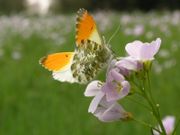
-
- — DevonDevonDevon is a large county in southwestern England. The county is sometimes referred to as Devonshire, although the term is rarely used inside the county itself as the county has never been officially "shired", it often indicates a traditional or historical context.The county shares borders with...
and west SomersetSomersetThe ceremonial and non-metropolitan county of Somerset in South West England borders Bristol and Gloucestershire to the north, Wiltshire to the east, Dorset to the south-east, and Devon to the south-west. It is partly bounded to the north and west by the Bristol Channel and the estuary of the...
; SurreySurreySurrey is a county in the South East of England and is one of the Home Counties. The county borders Greater London, Kent, East Sussex, West Sussex, Hampshire and Berkshire. The historic county town is Guildford. Surrey County Council sits at Kingston upon Thames, although this has been part of...
; BuckinghamshireBuckinghamshireBuckinghamshire is a ceremonial and non-metropolitan home county in South East England. The county town is Aylesbury, the largest town in the ceremonial county is Milton Keynes and largest town in the non-metropolitan county is High Wycombe....
and NorthamptonshireNorthamptonshireNorthamptonshire is a landlocked county in the English East Midlands, with a population of 629,676 as at the 2001 census. It has boundaries with the ceremonial counties of Warwickshire to the west, Leicestershire and Rutland to the north, Cambridgeshire to the east, Bedfordshire to the south-east,...
; and WorcestershireWorcestershireWorcestershire is a non-metropolitan county, established in antiquity, located in the West Midlands region of England. For Eurostat purposes it is a NUTS 3 region and is one of three counties that comprise the "Herefordshire, Worcestershire and Warwickshire" NUTS 2 region...
and HerefordshireHerefordshireHerefordshire is a historic and ceremonial county in the West Midlands region of England. For Eurostat purposes it is a NUTS 3 region and is one of three counties that comprise the "Herefordshire, Worcestershire and Gloucestershire" NUTS 2 region. It also forms a unitary district known as the...
- — Devon
Subfamily Coliadinae
Coliadinae
Coliadinae, the sulfurs, sulphurs, or yellows, are a subfamily of butterflies with about 300 described species.There are 36 species in North America, where they range from Mexico to northern Canada...
- Dark Clouded Yellow – Colias croceus
-
- — immigrant, though overwintering in south-west; north to River ClydeRiver ClydeThe River Clyde is a major river in Scotland. It is the ninth longest river in the United Kingdom, and the third longest in Scotland. Flowing through the major city of Glasgow, it was an important river for shipbuilding and trade in the British Empire....
in some years- Common Brimstone – Gonepteryx rhamni rhamni
- — throughout England (except north) and Wales (except south-west, central wet and far north-west)
- — immigrant, though overwintering in south-west; north to River Clyde
Subfamily Pierinae
Pierinae
The Pierinae are a large subfamily of Pierid butterflies. The subfamily is one of several clades of butterflies often referred to as the Whites...
- Large WhiteLarge WhiteThe Large White , also called Cabbage Butterfly, Cabbage White, or in India the Large Cabbage White, White cabbage butterfly is a butterfly in the family Pieridae.-Distribution:...
– Pieris brassicae
-
- — throughout, but thinly spread in north-west half of Scotland
- Small White – Pieris [Artogeia] rapae
- — throughout, except far north
- Green-veined WhiteGreen-veined WhiteThe Green-veined White is a butterfly of the Pieridae family.-Appearance and distribution:A circumboreal species widespread across Europe and Asia, including the Indian subcontinent, Japan and the Maghreb and North America...
– Pieris [Artogeia] napi - P. napi sabellicae — throughout (except for area occupied by subspecies thomsoni)
- P. napi thomsoni — east-central Scotland
- Orange Tip – Anthocharis cardamines britannica
- Green-veined White
- — throughout, except far north and north-west
- — throughout, but thinly spread in north-west half of Scotland
LycaenidaeLycaenidaeThe Lycaenidae are the second-largest family of butterflies, with about 6000 species worldwide, whose members are also called gossamer-winged butterflies...
– Hairstreaks, Coppers & Blues
.jpg)
Theclinae
Subfamily Theclinae is a group of butterflies, including the hairstreaks, elfins and allies, in the family Lycaenidae. There are many tropical species as well as a number found in the Americas. Tropical hairstreaks often have iridescent blue coloration above, caused by reflected light from the...
- Green HairstreakGreen HairstreakThe Green Hairstreak, Callophrys rubi, is a butterfly in the family Lycaenidae.Callophrys rubi is found in Europe, North Africa, Russia, Asia Minor, Siberia, Amurland , Baluchistan and Chitral....
– Callophrys rubi
-
- — throughout much of country
- Brown HairstreakBrown HairstreakThe Brown Hairstreak is a butterfly in the family Lycaenidae. The range includes most of the Palaearctic.-Subspecies:...
– Thecla betulae ‡
- Brown Hairstreak
- — south of River Humber, with concentrations in south-west Wales, north Devon and south-west Somerset, and west WealdWealdThe Weald is the name given to an area in South East England situated between the parallel chalk escarpments of the North and the South Downs. It should be regarded as three separate parts: the sandstone "High Weald" in the centre; the clay "Low Weald" periphery; and the Greensand Ridge which...
- Purple HairstreakPurple HairstreakThe Purple Hairstreak Neozephyrus quercus is a butterfly in the family Lycaenidae distributed throughout much of Europe. North Africa, Asia Minor, Caucasus and Transcaucasia....
– Neozephyrus [Quercusia] quercus
- Purple Hairstreak
- — throughout most of England and Wales, more thinly distributed north to River Clyde
- White-letter HairstreakWhite-letter HairstreakThe White-letter Hairstreak is a butterfly in the family Lycaenidae.-Appearance, behaviour and distribution:A dark little butterfly that spends the majority of its life in the tree tops, feeding on honeydew, making it best observed through binoculars. The uppersides are a dark brown with a small...
– Satyrium [Strymonidia] w-album ‡
- White-letter Hairstreak
- — throughout much of England (except far south-west and north-west) and eastern Wales
- Black HairstreakBlack HairstreakThe Black Hairstreak is a butterfly in the family Lycaenidae.-Appearance, behaviour and distribution:This small brown butterfly is one of Britain's most localised and rarest. At first glance it is very similar to the White-letter Hairstreak but the Black Hairstreak has a row of orange spots along...
– Satyrium [Strymonidia] pruni
- Black Hairstreak
- — confined to heavy clay soils along Chiltern hills
- — throughout much of country
Subfamily Lycaena
Lycaena
Lycaena is a butterfly genus with a world-wide range. It is commonly divided into several subgenera, such as Antipodolycaena. Many formerly independent genera are nowadays subsumed within Lycaena, and the genus Gaiedes may well belong herein too.-Species:Listed alphabetically within groups:The...

Small Copper
The Small Copper, American Copper, or the Common Copper is a butterfly of the Lycaenids or gossamer-winged butterfly family.- Description :thumb|left|Larva...
– Lycaena phlaeas eleus
-
- — throughout, except far north and north-west
Subfamily Polyommatinae
Polyommatinae
Polyommatinae, the blues, are a subfamily of gossamer-winged butterflies . It was long used to assign taxa of unclear relationships, and its contents are in need of revision...
- Small BlueSmall BlueThe Small Blue is a butterfly in the family Lycaenidae.It is found in Europe, Asia Minor, Transcaucasia, Tian-Shan, West Siberia, Central Siberia, South Siberia, Russian Far East, Amur, Mongolia, Magadan and Kamchatka....
– Cupido minimus ‡
-
- — southern and south-central England, south Wales coast, and east coast of Scotland (patchy distribution)
- Silver-studded BlueSilver-studded BlueThe Silver-studded Blue is a butterfly in the family Lycaenidae.-Appearance, behavior and distribution:So named due to the silvery blue metallic spots on the underside hind wings. The upperside are a rich, deep iridescent blue in the males with a black border and the characteristic Lycid white...
– Plebeius [Plebejus] argus ‡ - P. argus argus — south-west and south England, East AngliaEast AngliaEast Anglia is a traditional name for a region of eastern England, named after an ancient Anglo-Saxon kingdom, the Kingdom of the East Angles. The Angles took their name from their homeland Angeln, in northern Germany. East Anglia initially consisted of Norfolk and Suffolk, but upon the marriage of...
coast, and north Wales and north-east Wales borders - P. argus cretaceus — formerly on chalkChalkChalk is a soft, white, porous sedimentary rock, a form of limestone composed of the mineral calcite. Calcite is calcium carbonate or CaCO3. It forms under reasonably deep marine conditions from the gradual accumulation of minute calcite plates shed from micro-organisms called coccolithophores....
and limestoneLimestoneLimestone is a sedimentary rock composed largely of the minerals calcite and aragonite, which are different crystal forms of calcium carbonate . Many limestones are composed from skeletal fragments of marine organisms such as coral or foraminifera....
downlandDownlandA downland is an area of open chalk hills. This term is especially used to describe the chalk countryside in southern England. Areas of downland are often referred to as Downs....
of south and south-east coasts, now restricted to Portland BillPortland BillPortland Bill is a narrow promontory of Portland stone, which forms the most southerly part of Isle of Portland, and therefore also the county of Dorset, England.... - P. argus caernensis — Great Ormes Head (north Wales)
- P. argus masseyi — extinct (formerly north-west England)
- Brown ArgusBrown ArgusThe Brown Argus is a butterfly in the family Lycaenidae.-Appearance, behaviour and distribution:Although one of the "Blues" both sexes are brown on the uppersides with a band of orange spots at the border of each wing...
– Plebeius [Aricia] agestis
- Silver-studded Blue
- — throughout southern England, north to River TeesRiver TeesThe River Tees is in Northern England. It rises on the eastern slope of Cross Fell in the North Pennines, and flows eastwards for 85 miles to reach the North Sea between Hartlepool and Redcar.-Geography:...
, south and north coasts of Wales- Northern Brown ArgusNorthern Brown ArgusThe Northern Brown Argus is a butterfly in the family Lycaenidae.-Appearance, behaviour and distribution:This species has confused British entomologists for years. Since its discovery in Britain it has been thought to be a form or a subspecies of the Brown Argus Aricia agestis and as well as a...
– Plebeius [Aricia] artaxerxes ‡ - P. artaxerxes salmacis (Castle Eden Argus) — England from north LancashireLancashireLancashire is a non-metropolitan county of historic origin in the North West of England. It takes its name from the city of Lancaster, and is sometimes known as the County of Lancaster. Although Lancaster is still considered to be the county town, Lancashire County Council is based in Preston...
north - P. artaxerxes artaxerxes — Scotland
- Common BlueCommon BlueThe Common Blue is a small butterfly in the family Lycaenidae, widespread over much of the Palaearctic. Recently, Polyommatus icarus was discovered in Mirabel, Quebec, Canada by Ara Sarafian, an amateur entomologist who observed the butterfly from 2005 to 2008...
– Polyommatus icarus icarus
- Northern Brown Argus
- — throughout
- Chalkhill BlueChalkhill BlueThe Chalkhill Blue is a butterfly in the family Lycaenidae.Males have pale silvery-blue wings with black and white border . Females are dark brown, also with the black and white borders...
– Polyommatus [Lysandra] coridon
- Chalkhill Blue
- — southern England
- Adonis BlueAdonis BlueThe Adonis Blue is a butterfly in the family Lycaenidae.-Habitat:The preferred habitat of the adonis blue is calcareous grasslands with hot and dry conditions.-Species decline:...
– Polyommatus [Lysandra] bellargus
- Adonis Blue
- — south England
- Holly BlueHolly BlueThe Holly Blue , is a butterfly that belongs to the Lycaenids or Blues family and is native to Eurasia and North America.In India, it is known as the Hill Hedge Blue...
– Celastrina argiolus britanna
- Holly Blue
- — north to Solway FirthSolway FirthThe Solway Firth is a firth that forms part of the border between England and Scotland, between Cumbria and Dumfries and Galloway. It stretches from St Bees Head, just south of Whitehaven in Cumbria, to the Mull of Galloway, on the western end of Dumfries and Galloway. The Isle of Man is also very...
and River TyneRiver TyneThe River Tyne is a river in North East England in Great Britain. It is formed by the confluence of two rivers: the North Tyne and the South Tyne. These two rivers converge at Warden Rock near Hexham in Northumberland at a place dubbed 'The Meeting of the Waters'.The North Tyne rises on the...
- Large Blue – Glaucopsyche [Maculinea] arion ‡
- G. arion eutyphron (endemic subspecies) — extinctExtinctionIn biology and ecology, extinction is the end of an organism or of a group of organisms , normally a species. The moment of extinction is generally considered to be the death of the last individual of the species, although the capacity to breed and recover may have been lost before this point...
- G. arion arion — introduced to various sites in west England
- — southern and south-central England, south Wales coast, and east coast of Scotland (patchy distribution)
RiodinidaeRiodinidaeThe Riodinidae are a family of butterflies. The common name "metalmarks" refers to the small metallic-looking spots commonly found on their wings. There are approximately 1,000 species of metalmark butterflies in the world...
– Metalmarks
- Duke of BurgundyHamearis lucinaHamearis lucina, known as the Duke of Burgundy, is a European butterfly in the family Riodinidae. For many years, it was known as the "Duke of Burgundy Fritillary", because of the adult's similar markings to "true" fritillaries of the family Nymphalidae.-Description:The male has a wingspan of , and...
– Hamearis lucina ‡
-
- — central-south England; "pockets" in north-east, north-west and south-east England
NymphalidaeNymphalidaeThe Nymphalidae is a family of about 5,000 species of butterflies which are distributed throughout most of the world. These are usually medium sized to large butterflies. Most species have a reduced pair of forelegs and many hold their colourful wings flat when resting. They are also called...
– Fritillaries, Nymphalids & Browns
Subfamily HeliconiinaeHeliconiinae
The Heliconiinae, commonly called heliconians or longwings, are a subfamily of the brush-footed butterflies . They can be divided into 45-50 genera and were sometimes treated as a separate family Heliconiidae within the Papilionoidea...
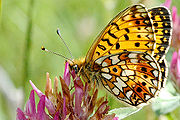
- Small Pearl-bordered FritillarySmall Pearl-bordered FritillaryThe Small Pearl-bordered Fritillary , called the Silver-bordered Fritillary in North America, is a butterfly of the Nymphalidae family...
– Boloria [Clossiana] selene ‡ - B. selene selene — widespread in Wales, Scotland, southern and northern England
- B. selene insularum — western Scotland and Inner HebridesInner HebridesThe Inner Hebrides is an archipelago off the west coast of Scotland, to the south east of the Outer Hebrides. Together these two island chains form the Hebrides, which enjoy a mild oceanic climate. There are 36 inhabited islands and a further 43 uninhabited Inner Hebrides with an area greater than...
- Pearl-bordered FritillaryPearl-bordered FritillaryThe Pearl-bordered Fritillary is a butterfly of the Nymphalidae family.It is orange with black spots on the upperside of its wing and has a wingspan of 38–46 mm. On the underside of the wings there is a row of silver pearly markings along the edge, which give the species its name...
– Boloria [Clossiana] euphrosyne ‡
-
- — patchily distributed through southern England, Wales, north-west and north-east England, and Scotland
- High Brown FritillaryHigh Brown FritillaryThe High Brown Fritillary is a butterfly of the Nymphalidae family, native from Europe across mainland Asia to Japan.The adults fly in July/August and lay eggs near to the larval food plants which are species of violets,...
– Argynnis [Fabriciana] adippe ‡
- High Brown Fritillary
- — patchy distribution in west England and Wales
- Dark Green FritillaryDark Green FritillaryThe Dark Green Fritillary is a butterfly of the Nymphalidae family.The insect has a wide range in the Palearctic ecozone - Europe, Morocco, Iran , Siberia, Central Asia, China, Korea and Japan.-Subspecies:...
– Argynnis [Mesoacidalia] aglaja - A. aglaja aglaja — patchy distribution throughout, except Scotland
- A. aglaja scotica — Scotland
- Silver-washed FritillarySilver-washed FritillaryArgynnis paphia is a common and variable butterfly found over much of the Palaearctic ecozone – Algeria, Europe, temperate Asia and Japan.-Subspecies:*A. p. butleri Krulikovsky, 1909 Northern Europe, Central Europe...
– Argynnis paphia
- Dark Green Fritillary
- — south-western half of England and Wales
- — patchily distributed through southern England, Wales, north-west and north-east England, and Scotland
Subfamily Limenitidinae
Limenitidinae
Limenitidinae is a subfamily of butterflies that includes the admirals and relatives. The common names of many species and genera reference military ranks or – namely the Adoliadini – titles of nobility , in reference to these butterflies' large size, bold pattern and dashing flight...
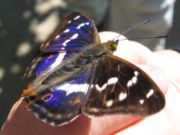
Limenitis camilla
The White Admiral, Limenitis camilla, is a butterfly of the Nymphalidae family. They are found in woodland throughout southern Britain and much of Europe and Asia, extending as far east as Japan....
– Limenitis camilla ‡
-
- — southern England and eastern Wales
Subfamily Apaturinae
Apaturinae
Apaturinae is a subfamily of butterflies that includes many species commonly called "emperors".-External links:* List of North American species with images.* Images.In Japanese but binomial names....
- Purple Emperor – Apatura iris
-
- — southern England
Subfamily Nymphalinae
Nymphalinae
Nymphalinae is a subfamily of brush-footed butterflies . Sometimes, the Limenitidinae are included here as further tribe, while the Melitaeini are occasionally considered a distinct subfamily.- Systematics:...
-
- — common immigrant throughout
- Painted LadyVanessa carduiVanessa cardui is a well-known colourful butterfly, known as the Painted Lady, or in North America as the Cosmopolitan. This butterfly has a strange pattern of flying in a sort of screw shape.-Distribution:...
– Vanessa (Cynthia) cardui
- Painted Lady
- — immigrant throughout
- Small TortoiseshellSmall TortoiseshellThe Small Tortoiseshell is a well-known colourful butterfly.-Range:It is found in temperate Europe, Asia Minor, Central Asia, Siberia, China, Mongolia, Korea and Japan. There are a few records from New York City which, however, are believed to have arrived human-assisted.-Subspecies:*A. u. urticae...
– Aglais urticae
- Small Tortoiseshell
- — throughout
- PeacockInachis ioThe European Peacock , more commonly known simply as the Peacock butterfly, is a colourful butterfly, found in Europe, temperate Asia as far east as Japan. It is the only member of the genus Inachis...
– Inachis io
- Peacock
- — throughout, except Scottish Highlands and Western Isles
- CommaComma (butterfly)The Comma is a species of butterfly that ranges across Europe and temperate Asia to Japan and south to Morocco. Similar species are found in the United States and Canada.-Subspecies:...
– Polygonia c-album
- Comma
- — throughout England and Wales, and spreading in southern Scotland
- — common immigrant throughout
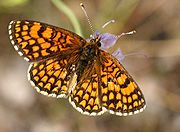
- Marsh FritillaryMarsh FritillaryThe Marsh Fritillary, Euphydryas aurinia, is a butterfly of the Nymphalidae family.It is widespread in the Palaearctic region from Ireland in the West to Yakutia in the East, and to North-west China and Mongolia in the South.E. aurinia is represented by many subspecies.The most widely accepted...
– Euphydryas [Eurodryas] aurinia ‡
-
- — patchy distribution, mostly in west
- Glanville FritillaryGlanville FritillaryThe Glanville Fritillary is a butterfly of the Nymphalidae family.The animal spends most of its life as a black, spiny caterpillar. The orange patterned butterfly lives only a few weeks....
– Melitaea cinxia ‡
- Glanville Fritillary
- — southern coast of Isle of WightIsle of WightThe Isle of Wight is a county and the largest island of England, located in the English Channel, on average about 2–4 miles off the south coast of the county of Hampshire, separated from the mainland by a strait called the Solent...
and Channel IslandsChannel IslandsThe Channel Islands are an archipelago of British Crown Dependencies in the English Channel, off the French coast of Normandy. They include two separate bailiwicks: the Bailiwick of Guernsey and the Bailiwick of Jersey...
(formerly widespread in south-east)- Heath FritillaryHeath FritillaryThe Heath Fritillary is a butterfly of the Nymphalidae family. It is found throughout the Palaearctic from Western Europe to Japan, in heathland, grassland, and in coppiced woodland. Its association with coppiced woodland earned it the name "Woodman's Follower" in parts of the UK...
– Melitaea [Mellicta] athalia ‡
- Heath Fritillary
- — West Country and Kent; re-introduced to EssexEssexEssex is a ceremonial and non-metropolitan county in the East region of England, and one of the home counties. It is located to the northeast of Greater London. It borders with Cambridgeshire and Suffolk to the north, Hertfordshire to the west, Kent to the South and London to the south west...
- — patchy distribution, mostly in west
Subfamily Satyrinae
Satyrinae
Satyrinae, the satyrines or satyrids, commonly known as the Browns, is a subfamily of the Nymphalidae . They were formerly considered a distinct family, Satyridae. This group contains nearly half of the known diversity of brush-footed butterflies...
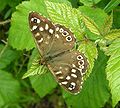
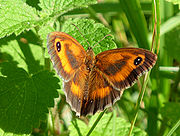
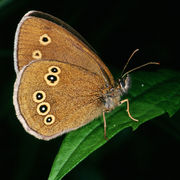
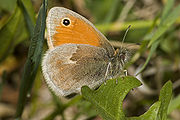
Speckled Wood
The Speckled Wood is a butterfly found in and on the borders of woodland throughout much of the Palearctic ecozone.In North Europe, Central Europe , Asia Minor, Syria, Russia and Central Asia where subspecies P. a. tircis occurs it is brown with pale yellow or cream spots and darker upperwing...
– Pararge aegeria
-
- — throughout England and Wales, southern Scotland (localized)
- Small Mountain Ringlet – Erebia epiphron ‡
- E. epiphron mnemon — CumbriaCumbriaCumbria , is a non-metropolitan county in North West England. The county and Cumbria County Council, its local authority, came into existence in 1974 after the passage of the Local Government Act 1972. Cumbria's largest settlement and county town is Carlisle. It consists of six districts, and in...
- E. epiphron scotica — central Scotland
- Scotch ArgusScotch ArgusThe Scotch Argus is a Palaearctic butterfly of the Nymphalidae family.It has a wide range including the French Alps , Germany , Balkans , Apennines , Asia Minor , the Urals, Caucasus and Sajan. In Britain it occurs in certain coastal areas of eastern Scotland such as Fowlsheugh.In Europe and...
– Erebia aethiops - E. aethiops aethiops — Cumbria
- E. aethiops caledonia — Scotland
- Marbled White – Melanargia galathea serena
- — throughout south-east half of the country, including West Country, but not most of East Anglia
- GraylingGrayling (butterfly)The Grayling is a species in the brush-footed butterfly family Nymphalidae. It sometimes occurs in coastal areas of northeast Scotland such as the Fowlsheugh Nature Reserve. It can also be found near the coast around England, such as Fire Beacon Hill...
– Hipparchia semele ‡ - H. semele semele — much of English coast, inland in parts of south and East Anglia
- H. semele scota — eastern Scotland (near coast)
- H. semele thyone — Wales
- H. semele atlantica — HebridesHebridesThe Hebrides comprise a widespread and diverse archipelago off the west coast of Scotland. There are two main groups: the Inner and Outer Hebrides. These islands have a long history of occupation dating back to the Mesolithic and the culture of the residents has been affected by the successive...
- Gatekeeper – Pyronia tithonus britanniae
- Grayling
- — throughout southern half of country, except central Wales
- Meadow BrownMeadow BrownThe Meadow Brown, Maniola jurtina, is a butterfly found in European meadows, where its larvae feed on grasses, such as Sheep's Fescue.Similar species are Gatekeeper and Small Heath ....
– Maniola jurtina - M. jurtina insularis — throughout (except for areas occupied by other subspecies)
- M. jurtina cassiteridum — Scilly Isles
- M. jurtina splendida — western Scotland, including Hebrides
- Ringlet – Aphantopus hyperantus
- Meadow Brown
- — throughout, except north-west England and north-west half of Scotland
- Small HeathSmall Heath (butterfly)The Small Heath Coenonympha pamphilus is a butterfly species belonging to the family Nymphalidae, . It is widespread in Eurasia and northwestern Africa, preferring drier habitats than other Coenonymphae...
– Coenonympha pamphilus ‡* - C. pamphilus pamphilus — throughout, except far north and Hebrides
- C. pamphilus rhoumensis — Hebrides
- Large HeathLarge HeathThe Large Heath or Common Ringlet is a butterfly in the family Nymphalidae. It flies in variety of grassy habitats, including roadsides, woodland edges and clearings, prairies, bogs, and arctic and alpine taiga and tundra. It is a poor flyer, but can sometimes be found along ditches seeking new...
– Coenonympha tullia ‡ - C. tullia davus — patchy distribution throughout northern and central England
- C. tullia polydama — central-west and north Wales, northern England and southern Scotland
- C. tullia scotica — rest of Scotland
- Small Heath
- — throughout England and Wales, southern Scotland (localized)
Vagrant, Extinct and Exotic Species
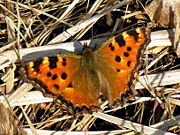
- Arran BrownErebia ligeaThe Arran Brown is a member of the Satyridae subfamily of Nymphalidae. This brown is widespread in southeastern and northern Europe. It prefers mixed woodlands at low altitudes. It is rarely seen on open areas....
– Erebia ligea - Black-veined White – Aporia crataegi
- Mazarine BlueMazarine BlueThe Mazarine Blue is a butterfly in the family Lycaenidae. The wingspan of the male and female are similar, at 32-38 mm....
– Polyommatus [Cyaniris] semiargus (now vagrant only) - Large CopperLarge CopperThe Large Copper is a butterfly of the family Lycaenidae.The insect has a wide range occurring throughout the Northern Palearctic ecozone north to the middle taiga zone .-Subspecies:...
– Lycaena dispar (Great Britain subspecies extinct; continental subspecies introduced now also extinct) - Large TortoiseshellLarge TortoiseshellThe Blackleg Tortoiseshell or Large Tortoiseshell is a butterfly of the family Nymphalidae. Although it looks very like the Small Tortoiseshell , it is more closely related to the Camberwell Beauty. It is now an extreme rarity in Britain, although it used to be widespread throughout England and...
– Nymphalis polychloros (now vagrant only, although sightings in southern England in 2007 suggest recolonisation may be occurring) - Almond-eyed Ringlet – Erebia alberganus
Vagrants
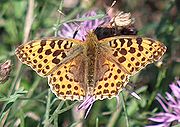
- Pale Clouded YellowPale Clouded YellowPale Clouded Yellow is a small butterfly of the Family Pieridae, that is, the Yellows and Whites, which is found in most of Europe and large parts of Asia.-References:* Evans, W.H. The Identification of Indian Butterflies...
– Colias hyale - Berger's Clouded Yellow – Colias sareptensis
- Bath WhiteBath WhiteThe Bath White is a small butterfly of the family Pieridae, the Yellows and Whites, which occurs in the Palearctic region...
– Pontia daplidice - Dappled WhiteMountain Dappled WhiteThe Mountain Dappled White is a butterfly found in the mountainous regions of Western Europe and Northern Africa. Its main foods are sinapis, isatis, athionema, iberis and biscutella species....
– Euchloe simplonia - Long-tailed Blue – Lampides boeticus
- Lang's Short-tailed Blue – Leptotes pirithous
- Scarce SwallowtailScarce SwallowtailThe Scarce Swallowtail is a Palearctic swallowtail butterfly found in gardens, fields and open woodlands. First described by Linnaeus in 1758, it is found in places with sloe thickets and particularly orchards. It is also called Sail Swallowtail or Pear-tree Swallowtail...
– Iphiclides podalirius - Short-tailed BlueShort-tailed BlueThe Short-tailed Blue or Tailed Cupid is a butterfly in the family Lycaenidae. It is found from Central Europe to Japan.-Description:...
– Cupido [Everes] argiades - Geranium BronzeGeranium BronzeThe Geranium Bronze or Brun des pélargoniums in French is a butterfly in the family Lycaenidae.The wingspan is 15–23 mm for males and 18–27 mm for females. Adults are on wing year round in warmer areas, but usually from August to May in South Africa...
– Cacyreus marshalli (imported on geraniums) - Camberwell Beauty – Nymphalis antiopa
- MapMap (butterfly)The Map is a butterfly of the Nymphalidae family. It is common throughout the lowlands of central and eastern Europe, and is expanding its range in western Europe....
– Araschnia levana (formerly introduced and bred) - Queen of Spain FritillaryQueen of Spain FritillaryThe Queen of Spain Fritillary is a butterfly of the family Nymphalidae.-Range:It occurs throughout the Palaearctic from North Africa to Japan...
– Issoria lathonia - MonarchMonarch butterflyThe Monarch butterfly is a milkweed butterfly , in the family Nymphalidae. It is perhaps the best known of all North American butterflies. Since the 19th century, it has been found in New Zealand, and in Australia since 1871 where it is called the Wanderer...
– Danaus plexippus - ApolloApollo (butterfly)The Apollo or Mountain Apollo , is a butterfly of the Papilionidae family.-Distribution and status:It is found on mountains in Europe usually above up to , preferring flowery meadows and mountain pastures...
– Parnassius apollo - American Painted LadyAmerican Painted LadyThe American Painted Lady or American Lady is a butterfly found throughout North America.Vanessa virginiensis lives in flowery habitats, usually in mountains. The larvae feed on various Asteraceae, especially the cudweeds of genus Gnaphalium...
– Vanessa virginiensis
Exotics
Species included in the Great Britain Lepidoptera numbering system, but believed never to have occurred naturally in a wild state
- Fiery SkipperFiery skipperThe Fiery Skipper is a butterfly of the family Hesperiidae and are approximately 1 inch long. The males are orange or yellow with black spots while the females are dark brown with orange or yellow spots. The caterpillars are greenish pink with a black head...
– Hylephila phyleus - Mallow Skipper – Carcharodus alceae
- Oberthür's Grizzled SkipperOberthür's Grizzled SkipperOberthür's Grizzled Skipper is a species of skipper . It is found throughout Europe although it is commoner in the south and absent from the British Isles and most of Scandinavia....
– Pyrgus armoricanus - Small ApolloParnassius phoebusParnassius phoebus, known as the Phoebus Apollo or Small Apollo, is a butterfly species of the family of Swallowtail butterflies found in Eurasia and North America.P...
– Parnassius phoebus - Spanish Festoon – Zerynthia rumina
- Southern FestoonZerynthia polyxenaThe Southern Festoon is a striking butterfly belonging to the Papilionidae family of butterflies with a wingspan of 60–80 mm. Its flight time is from April to June in a single brood.- Distribution :...
– Zerynthia polyxena - Tiger SwallowtailEastern tiger swallowtailThe Eastern Tiger Swallowtail is a species of swallowtail butterfly native to North America. It is one of the most familiar butterflies in the eastern United States, where it is common in many different habitats. It flies from spring to fall, during which it produces two to three broods...
– Papilio glaucus - Moorland Clouded Yellow – Colias palaeno
- CleopatraGonepteryx cleopatraGonepteryx cleopatra is a medium sized butterfly of the family Pieridae that is native to the Mediterranean region ....
– Gonepteryx cleopatra - Slate FlashRapala schistaceaThe Slate Flash, Rapala schistacea is a species of lycaenid or blue butterfly found in Asia. It is mostly considered to be a subspecies of Rapala maneathumb|left|Female Upperside photo taken in [[Bangalore]]...
– Rapala schistacea - Scarce CopperScarce copperThe Scarce Copper, Lycaena virgaureae, is a butterfly of the family Lycaenidae .-Appearance:...
– Lycaena virgaureae - Sooty Copper – Lycaena tityrus
- Purple-shot CopperPurple-Shot CopperThe Purple-Shot Copper is a butterfly in the family of the Lycaenidae or copper butterflies and in the genus of the Lycaena....
– Lycaena alciphron - Purple-edged CopperPurple-edged CopperThe Purple-edged Copper is a butterfly of the family Lycaenidae.* Length of male: 16–17 mm.* Period of flight: June–July, one generation, range around 1500 m.* Plants favoured: Rumex spp...
– Lycaena hippothoe - Turquoise BlueTurquoise BlueThe Turquoise Blue is a butterfly of the Lycaenidae family.It is found in South Europe, Asia Minor, Ural Mountains, Caucasus and Transcaucasia.Wingspan is 15-17 mm...
– Plebicula dorylas - Green-underside Blue – Glaucopsyche alexis
- Julia – Dryas julia
- Albin's Hampstead Eye – Junonia villida
- Blue Pansy – Junonia oenone
- ZebraColobura dirceThe Dirce Beauty, also known as the Mosaic or Zebra Mosaic, is a butterfly of the Nymphalidae family. It is found in Central America and the Northern parts of South America.The length of the fore-wings is about 33 mm....
– Colobura dirce - Small Blown Shoemaker – Hypanartia lethe
- Indian Red Admiral – Vanessa indica
- Scarce TortoiseshellNymphalis xanthomelasThe Scarce Tortoiseshell is a species of nymphalid butterfly found in Asia. This butterfly is also referred as Yellow-legged Tortoisehell or Large Tortoiseshell .-Description:Upper side rich orange-yellow, Fore wing has costal margin dusky black on...
– Nymphalis xanthomelas - Weaver's Fritillary – Boloria dia
- Aphrodite FritillaryAphrodite FritillaryThe Aphrodite Fritillary is a fritillary from North America.This orange coloured fritillary has rows of dark dots or chevrons at the wing edges and black or brown lines more proximally. The ventral side of the wings are also orange with several rows of white dots. Its wingspan is between 51 and...
– Argynnis aphrodite - Niobe FritillaryNiobe FritillaryThe Niobe Fritillary is a butterfly of the Nymphalidae family. It is common throughout Europe, but absent from Northern Europe, and is also found in Siberia, Russia, Iran, China, and Korea...
– Argynnis niobe - CardinalArgynnis pandoraThe Cardinal is a butterfly of the Nymphalidae family. It is common throughout southern Europe, but is also found in northern Africa, and western and central Asia....
or Mediterranean Fritillary – Argynnis pandora - Spotted Fritillary – Melitaea didyma
- Large WallLarge WallThe Large Wall Brown is a butterfly in the family Nymphalidae. The species is common in continental Europe. Though it is an avid flyer It is seldom seen on flight in strong wind. Its preferred habitats are edges of the forests and unmanaged clearings on forested areas. The larva eats full grown...
– Lasiommata maera - Woodland Grayling – Hipparchia fagi
- HermitChazara briseisThe Hermit is a butterfly species belonging to the family Nymphalidae. It can be found in North Africa, Southern Europe, Asia Minor, the Caucasus, Kazakhstan, Middle Asia through Afghanistan, and North-Western China and Tuva....
– Chazara briseis - False Grayling – Arethusana arethusa
See also
- Butterfly ConservationButterfly ConservationButterfly Conservation is an insect conservation organisation in the United Kingdom. It is one of the largest insect conservation organisations in the world.-History of the Organisation:...
– Britain's butterfly and moth conservation society - List of butterflies of Ireland
- List of moths of Great Britain

